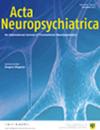Association Between Cortical Thickness or Surface Area and Divergent Thinking in Patients with Bipolar Disorder
IF 2.5
4区 医学
Q1 Medicine
引用次数: 0
Abstract
Objective: Divergent thinking is a critical creative cognitive process. Its neural mechanisms have been well-studied through structural and functional imaging in healthy individuals but are less explored in patients with bipolar disorder (BD). Because of the traditional link between creativity and BD, this study investigated the structural correlates of divergent thinking in patients with BD through surface-based morphometry. Methods: Fifty-nine patients diagnosed with BD I or BD II (35.3 ± 8.5 years) and 56 age- and sex-matched controls (33.9 ± 7.4 years) were recruited. The participants underwent structural magnetic resonance imaging and an evaluation of divergent thinking by using the Chinese version of the Abbreviated Torrance Test for Adults (ATTA). FreeSurfer 7.0 was used to generate thickness and surface area maps for each participant. Brainwise regression of the association between cortical thickness or surface area and ATTA performance was conducted using general linear models. Results: Divergent thinking performance did not differ significantly between the patients with BD and the healthy controls. In these patients, total ATTA score was negatively correlated with cortical thickness in the right middle frontal gyrus, right occipital, and left precuneus but positively correlated with the surface area of the right superior frontal gyrus. By contrast, total ATTA scores and cortical thickness or surface area were not significantly correlated among the controls. Conclusion: The findings indicate that divergent thinking involves cerebral structures for executive control, mental imagery, and visual processing in patients with BD, and the right prefrontal cortex might be the most crucial of these structures.双相情感障碍患者皮质厚度或表面积与发散性思维之间的关系
目标发散思维是一种重要的创造性认知过程。其神经机制已通过结构和功能成像对健康人进行了深入研究,但对躁狂症(BD)患者的研究较少。由于创造力与躁狂症之间的传统联系,本研究通过基于表面的形态测量法研究了躁狂症患者发散思维的结构相关性。研究方法招募了 59 名诊断为 BD I 或 BD II 的患者(35.3 ± 8.5 岁)和 56 名年龄和性别匹配的对照组患者(33.9 ± 7.4 岁)。参与者均接受了结构性磁共振成像检查,并使用中文版简略托伦斯成人测验(ATTA)对发散性思维进行了评估。使用 FreeSurfer 7.0 为每位参与者生成厚度和表面积图。使用一般线性模型对皮层厚度或表面积与 ATTA 成绩之间的关联进行脑回归。结果显示发散性思维能力在 BD 患者和健康对照组之间没有明显差异。在这些患者中,ATTA总分与右额叶中回、右枕叶和左楔前叶的皮质厚度呈负相关,但与右额叶上回的表面积呈正相关。相比之下,对照组的 ATTA 总分与皮质厚度或表面积无明显相关性。结论研究结果表明,BD 患者的发散性思维涉及执行控制、心理想象和视觉处理的大脑结构,而右侧前额叶皮层可能是其中最关键的结构。
本文章由计算机程序翻译,如有差异,请以英文原文为准。
求助全文
约1分钟内获得全文
求助全文
来源期刊

Acta Neuropsychiatrica
医学-精神病学
CiteScore
8.50
自引率
5.30%
发文量
30
审稿时长
6-12 weeks
期刊介绍:
Acta Neuropsychiatrica is an international journal focussing on translational neuropsychiatry. It publishes high-quality original research papers and reviews. The Journal''s scope specifically highlights the pathway from discovery to clinical applications, healthcare and global health that can be viewed broadly as the spectrum of work that marks the pathway from discovery to global health.
 求助内容:
求助内容: 应助结果提醒方式:
应助结果提醒方式:


